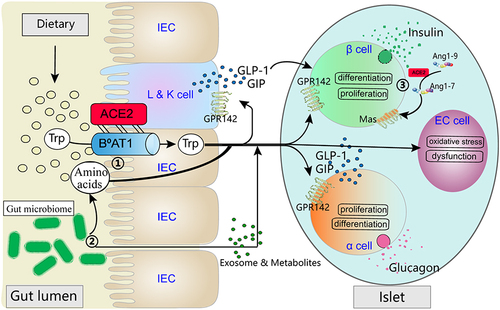Figures & data
Figure 1 ① ACE2 forms a dimeric complex with the neutral amino acid transporter B0AT1 to regulate the transport of tryptophan in intestinal epithelial cells. Amino acids such as tryptophan, in turn, acts on the intestine to promote the secretion of intestinal endocrine hormones. In addition, circulating tryptophan reaches the islets, where it plays a role in regulating the function, proliferation, and differentiation of β cells. Moreover, tryptophan indirectly affects β cell function by acting on α cells. ② Intestinal microbiota plays a dual role in the regulation of amino acid absorption and metabolism. On one hand, it can directly impact these processes. On the other hand, the microbiota-derived products, such as exosomes and endotoxins, can act on the intestine and islets, directly or indirectly participating in the regulation of the gut-islets axis. ③ ACE2 catalyzes and inhibits the effects of Angiotensin II (AngII), producing Ang1-7, which acts on the Mas receptor to form the local ACE2/Ang1-7/MasR axis in the islets. This activation reduces the dedifferentiation of β cells under metabolic stress conditions and improves their function.

